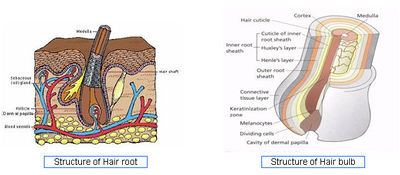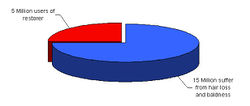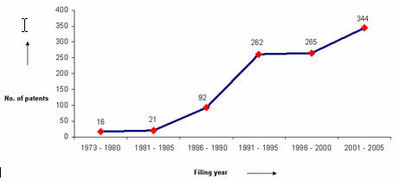Difference between revisions of "Alopecia - Hair Loss"
From DolceraWiki
| Line 1: | Line 1: | ||
| + | {{TOCrightEx}} | ||
| + | == Rationale == | ||
| + | * "Medication for men plagued by hair loss has become a topic of interest in Japan since a drug company began marketing it at the end of last year." March 5th, 2006 – [http://stophair.setupmyblog.com/?p=55 source] | ||
| + | * "An increasing number of companies are apparently turning the Chinese fear of a bald spot into big bucks with some doing so well they are branching out into other countries." February 16, 2006 – [http://stophair.setupmyblog.com/] | ||
| + | |||
| + | * "There is something in the air, or should we say in the hair, these days. Scientific research into hair loss remedies has never been more active or more exciting." June 7, 2006 - [http://www.prnewswire.com/cgi-bin/stories.pl?ACCT=109&STORY=/www/story/06-07-2005/0003821470&EDATE=] | ||
| + | |||
| + | == Alopecia IPMap == | ||
| + | [http://www.dolcera.com/client/d8r3/hairloss_map.htm Dolcera IPMap for Alopecia] | ||
| + | |||
| + | == Introduction == | ||
| + | |||
| + | === Hair basics === | ||
| + | * Hair is a complex and delicate part of the body. | ||
| + | * Keeping it healthy and beautiful is a challenge. | ||
| + | * Hair grows everywhere on the body with the exception of lips, eyelids, palms of the hands and soles of the feet. | ||
| + | * Hair is basically a form of skin. | ||
| + | * Hair is made up of a protein called keratin. | ||
| + | * Each shaft of hair is made of two or three inter-twined layers of keratin which grow from a follicle beneath the skin. | ||
| + | * Hair Structure - [http://www.pg.com/science/haircare/hair_twh_12.htm] | ||
| + | * Hair Cycle - [http://www.follicle.com/hair-structure-life-cycle.html] | ||
| + | |||
| + | [[Image:Hairbasics.jpg|center|400px|Structure of Hair root and Hair bulb]] | ||
| + | |||
| + | === What causes hair loss? === | ||
| + | * Decrease in growth of hair | ||
| + | * Increase in shedding of hair | ||
| + | * Breakage of hair | ||
| + | * Conversion of thick terminal hairs to thin vellus hairs | ||
| + | [[Image:Facts.jpg|thumb|right|250px|Survey results from Japan]] | ||
| + | Both men and women lose hair for similar reasons. Hair loss in men is often more dramatic, and follows a specific pattern of loss, one of which has been termed “Male Pattern Baldness" or "Androgenetic Alopecia". | ||
| + | |||
| + | === Types of alopecia=== | ||
| + | |||
| + | * Alopecia Areata (AA): Hair loss occurring in patches anywhere on the body. | ||
| + | * Alopecia Totalis (AT): Total loss of the hair on the scalp. | ||
| + | * Alopecia Universalis (AU): Total loss of all hair on the body. | ||
| + | * Alopecia Barbae: Loss of facial hair (for a man) especially in the beard area. | ||
| + | * Alopecia Mucinosa: A type of alopecia which results in scaley patches. | ||
| + | * Androgenetic Alopecia (AGA): Also known as male pattern baldness. It is a thinning of the hair to an almost transparent state, in both men or women. It is thought to be a hereditary form of hair loss. | ||
| + | * Traction Alopecia: Traction alopecia is usually due to excessive pulling or tension on hair shafts as a result of certain hair styles. It is seen more often in women, particularly those of East Indian and Afro-Caribbean origin. Hair loss depends on the way the hair is being pulled. Prolonged traction alopecia can stop new hair follicles from developing and leads to permanent hair loss. | ||
| + | * Anagen Effluvium: This hair loss is generally caused by chemicals such as those used to treat cancer. Initially it causes patchy hair loss, which often then leads to total hair loss. The good news is that when you stop using these chemicals the hair normally grows back (usually about 6 months later). Other drugs also can cause hair loss. Many medicines used to treat even common diseases can cause hair loss. | ||
| + | * Scarring Alopecia: A form of alopecia which leaves scarring on the area of hair loss. | ||
| + | * Telogen Effluvium: A form of hair loss where more than normal numbers of hair fall out. There is a general 'thinning' of the hair. Unlike some other hair and scalp conditions, it is temporary and the hair growth usually recovers. ([http://www.alopeciaonline.org.uk/about/types.asp Source]) | ||
| + | |||
| + | === Androgenetic alopecia === | ||
| + | * Gradual onset | ||
| + | * Transition from large, thick, pigmented terminal hairs to thinner, shorter, indeterminate hairs and finally to short, wispy, non-pigmented vellus hairs in the involved areas | ||
| + | * Characterized by a receding hairline and/or hair loss on the top of the head | ||
| + | |||
| + | '''Main causes''' | ||
| + | * Genetic predisposition | ||
| + | * Hormonal effect of androgen | ||
| + | * Reduction of blood circulation around hair follicle | ||
| + | * Deactivation of hair matrix cells | ||
| + | |||
| + | '''Some facts from Japan''' | ||
| + | |||
| + | * Market size: ¥ 30 Billion | ||
| + | * Number of products: more than 100 | ||
| + | |||
| + | (JICST-EPlus - Japanese Science & Technology) | ||
| + | |||
| + | == IP activity over the years == | ||
| + | The graph indicates: | ||
| + | * Number of patents filed every 5 years (except for first 7 years). | ||
| + | * First solution proposed in 1973 | ||
| + | * Filing trend indicates steep rise in activity recently. | ||
| + | [[Image:Year1.jpg|thumb|center|400px|IP Activity over years]] | ||
| + | |||
| + | == Major players == | ||
| + | [[Image:players.jpg|thumb|left|400px|Assignees with more than 20 patents ]] | ||
| + | [[Image:players1.jpg|thumb|center|400px|Assignees with fewer than 20 patents ]]<br> | ||
| + | |||
| + | * '''Active assignees''' | ||
| + | Assignees currently active with more than 5 patents to their credit during 2000-2005. | ||
| + | * Warner with 9 patents, | ||
| + | * Bristol with 6 and | ||
| + | * Abbott with 5. | ||
| + | |||
| + | [[Image:Active.jpg|thumb|center|500px|Active Assignees]] | ||
Revision as of 03:55, 16 July 2007
Rationale
- "Medication for men plagued by hair loss has become a topic of interest in Japan since a drug company began marketing it at the end of last year." March 5th, 2006 – source
- "An increasing number of companies are apparently turning the Chinese fear of a bald spot into big bucks with some doing so well they are branching out into other countries." February 16, 2006 – [1]
- "There is something in the air, or should we say in the hair, these days. Scientific research into hair loss remedies has never been more active or more exciting." June 7, 2006 - [2]
Alopecia IPMap
Introduction
Hair basics
- Hair is a complex and delicate part of the body.
- Keeping it healthy and beautiful is a challenge.
- Hair grows everywhere on the body with the exception of lips, eyelids, palms of the hands and soles of the feet.
- Hair is basically a form of skin.
- Hair is made up of a protein called keratin.
- Each shaft of hair is made of two or three inter-twined layers of keratin which grow from a follicle beneath the skin.
- Hair Structure - [3]
- Hair Cycle - [4]
What causes hair loss?
- Decrease in growth of hair
- Increase in shedding of hair
- Breakage of hair
- Conversion of thick terminal hairs to thin vellus hairs
Both men and women lose hair for similar reasons. Hair loss in men is often more dramatic, and follows a specific pattern of loss, one of which has been termed “Male Pattern Baldness" or "Androgenetic Alopecia".
Types of alopecia
- Alopecia Areata (AA): Hair loss occurring in patches anywhere on the body.
- Alopecia Totalis (AT): Total loss of the hair on the scalp.
- Alopecia Universalis (AU): Total loss of all hair on the body.
- Alopecia Barbae: Loss of facial hair (for a man) especially in the beard area.
- Alopecia Mucinosa: A type of alopecia which results in scaley patches.
- Androgenetic Alopecia (AGA): Also known as male pattern baldness. It is a thinning of the hair to an almost transparent state, in both men or women. It is thought to be a hereditary form of hair loss.
- Traction Alopecia: Traction alopecia is usually due to excessive pulling or tension on hair shafts as a result of certain hair styles. It is seen more often in women, particularly those of East Indian and Afro-Caribbean origin. Hair loss depends on the way the hair is being pulled. Prolonged traction alopecia can stop new hair follicles from developing and leads to permanent hair loss.
- Anagen Effluvium: This hair loss is generally caused by chemicals such as those used to treat cancer. Initially it causes patchy hair loss, which often then leads to total hair loss. The good news is that when you stop using these chemicals the hair normally grows back (usually about 6 months later). Other drugs also can cause hair loss. Many medicines used to treat even common diseases can cause hair loss.
- Scarring Alopecia: A form of alopecia which leaves scarring on the area of hair loss.
- Telogen Effluvium: A form of hair loss where more than normal numbers of hair fall out. There is a general 'thinning' of the hair. Unlike some other hair and scalp conditions, it is temporary and the hair growth usually recovers. (Source)
Androgenetic alopecia
- Gradual onset
- Transition from large, thick, pigmented terminal hairs to thinner, shorter, indeterminate hairs and finally to short, wispy, non-pigmented vellus hairs in the involved areas
- Characterized by a receding hairline and/or hair loss on the top of the head
Main causes
- Genetic predisposition
- Hormonal effect of androgen
- Reduction of blood circulation around hair follicle
- Deactivation of hair matrix cells
Some facts from Japan
- Market size: ¥ 30 Billion
- Number of products: more than 100
(JICST-EPlus - Japanese Science & Technology)
IP activity over the years
The graph indicates:
- Number of patents filed every 5 years (except for first 7 years).
- First solution proposed in 1973
- Filing trend indicates steep rise in activity recently.
Major players
- Active assignees
Assignees currently active with more than 5 patents to their credit during 2000-2005.
- Warner with 9 patents,
- Bristol with 6 and
- Abbott with 5.





